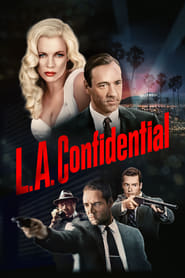With its patina of glamour and hard-boiled interior, it is a period film that looks as if it could have been produced in 1950s Hollywood if studio self-censorship hadn't gotten in the way of all the sex and the sadism, the institutional racism and government corruption. A period piece that follows the contours (if not the conventions) of the classical studio system and, at the same time, critiques that system by exposing everything the movies once refused to reveal.[…]
Because of Ellroy's dense plotting, Hanson and Helgeland spend the first half an hour of the film establishing the three detectives in their respective and shared milieus. Hanson maintains a light directorial touch throughout the preliminaries, using familiar devices such as montage and voiceover to get across, as expediently and as seamlessly as possible, a daunting amount of information. With the introduction over, however, he starts to make the film his own, which is what he does at the Nite Owl, the scene in which L.A. Confidential ceases to belong to James Ellroy and becomes Curtis Hanson's. Thereafter the story will be secondary to the people pushing it forward, secondary to how shadows fall across faces, to how music fills rooms, to the ways in which the characters circle one another and to how the camera moves through space.
— Manohla Dargis: BFI Film Classics: L.A. Confidential (2003)

